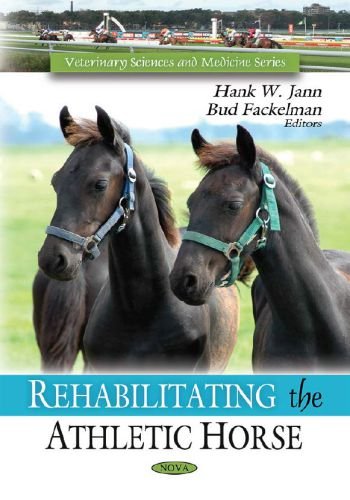Rehabilitating The Athletic Horse 1st Edition
By Jann, Hank W., Fackelman, Bud, Year 2010, File Type: PDF

This is a book about the restitution of soundness in horses which have been trained under seemingly ideal conditions, and nonetheless suffered injury. Most of the book’s authors have had direct experience in performing medical and surgical interventions designed to correct athletic injuries. Most of the authors have also been directly involved in the conditioning techniques designed to not only render their own charges ready for competition, but also ready to win.
The book will suggest how things can “go wrong” even with man’s best-laid plans. The text will then describe the path back from athletic injuries based upon that which is known about equine anatomy and physiology, and draw upon experience in human rehabilitation where applicable.
Some chapters will focus on how and when to apply therapeutic techniques, while others will describe in detail how, why and when those techniques are most beneficial. For instance, there are many measures which might be taken to treat a wound in such a way to enhance its healing, but have the psychological effects of relative isolation and inactivity shown to retard wound healing in laboratory animals, and almost assuredly operative in the healing of equine wounds, been considered?
It is anticipated Rehabilitating The Athletic Horse 1st Edition will continuously evolve as even more is learned about the physiology of injury in horses and come to better understand how it might be prevented. For instance, what role does exhaustion play in the blunting of proprioceptive sense? The bones of a horse, when tested in vitro, can withstand any and all of the pressures theoretically placed upon them by running at speed. However, if no longer supported by a surrounding musculature, therefore loaded in unphysiologic ways, they fail. How can training for stamina at this basic level be better? There is hope to find out soon. Get More: Veterinary Treatment for Working Equines
The mental and emotional aspects of rehabilitation are too often underemphasized or completely neglected. Horses in long term confinement situations often develop dysfunctional behavior patterns that can be difficult if not impossible to correct. This chapter is divided into four segments: 1) a typical case history 2) an explanation of why the mental and emotional aspects of equine veterinary care and rehabilitation can be problematic 3) specific mental and emotional aspects that must be considered during rehabilitation 4) and recommendations for improved care and increased success before, during and after the rehabilitation process occurs.
Direct Link For Paid Membership: –
